Affiliate disclosure: This post may contain affiliate links. Please see our Privacy Policy.
Nanking cherry (prunus tomentosa) is a unique fruit to western growers, but it’s been cultivated in the east for millennia. The small fruits look like cherries, but they’re actually more closely related to plums.
Though Nanking cherries are only about 1/2 inch in diameter, the plants produce huge crops with little maintenance. What they lack in size, they make up for in yields and vigor.
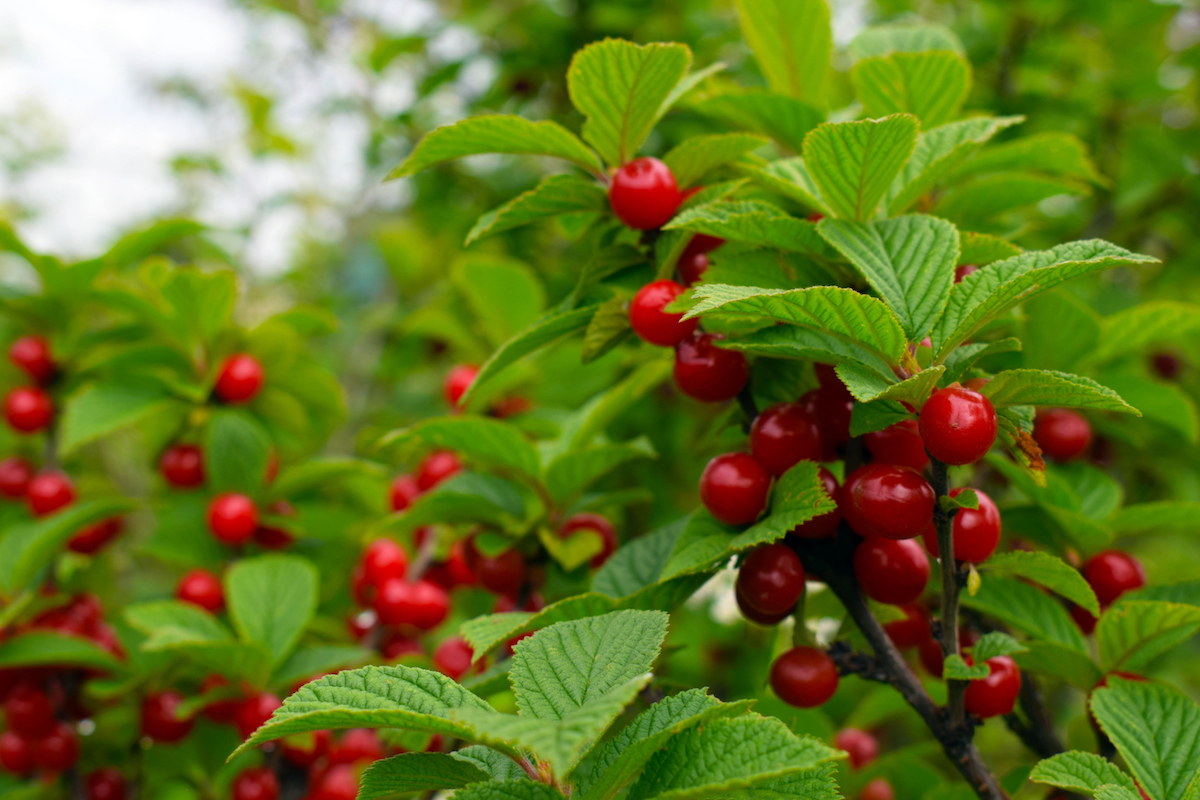
Native to China, Tibet, Korea, and Mongolia, Nanking cherries are grown for both their fruit and flowers.
The flowers are edible, like any cherry or plum tree flowers, and they’re added to dishes for a light sweet floral flavor. They’re also stunning visually, as Nanking cherry blossoms coat the stems of the bushes before the leaves have emerged in the early spring.
They look a bit like pink forsythia, decorating the landscape before the grass has begun to green up in the mud season landscape.

Where Does Nanking Cherry Grow?
Nanking cherry trees are native to central Asia; they grow wild throughout China, Japan, and the Himalayas. In the 1880s, immigrants brought the tree over to the United States.
Since they’re native to cold regions, it makes sense that they’d thrive in similar climates. Nanking cherries are hardy in USDA zones 3-6.
Picking the right location for your nanking cherry trees is vital. These trees are known for being low maintenance, but that implies optimal growing conditions.
The best spot for a nanking cherry tree is in a sunny location with a minimum of six to eight hours of sunlight. They’re strong trees, tolerating windy conditions, so many people use them for windbreaks.
Some say that these shrubs tolerate light shade, and reports say that some wild nanking cherry shrubs grow well in deep shade. For at-home growing purposes, stick to find a spot with plenty of sunlight.
Be sure to consider the mature size. A nanking cherry reaches up to 15 feet tall with a 15 feet spread in diameter at full maturity. Look at any current trees around it or buildings that might cast too much shade when in full bloom.
Nanking cherry will not tolerate juglone, which is a natural chemical produced by black walnut trees. Make sure they are not anywhere near your tree nor any of its relatives (such as butternut trees).
Nanking cherry adapts to many varieties of soil types and pH ranges. It grows best in well-drained, loamy soil, but it is drought-tolerant. These shrubs prefer neutral soil in the 6.1 to 7.0 range.
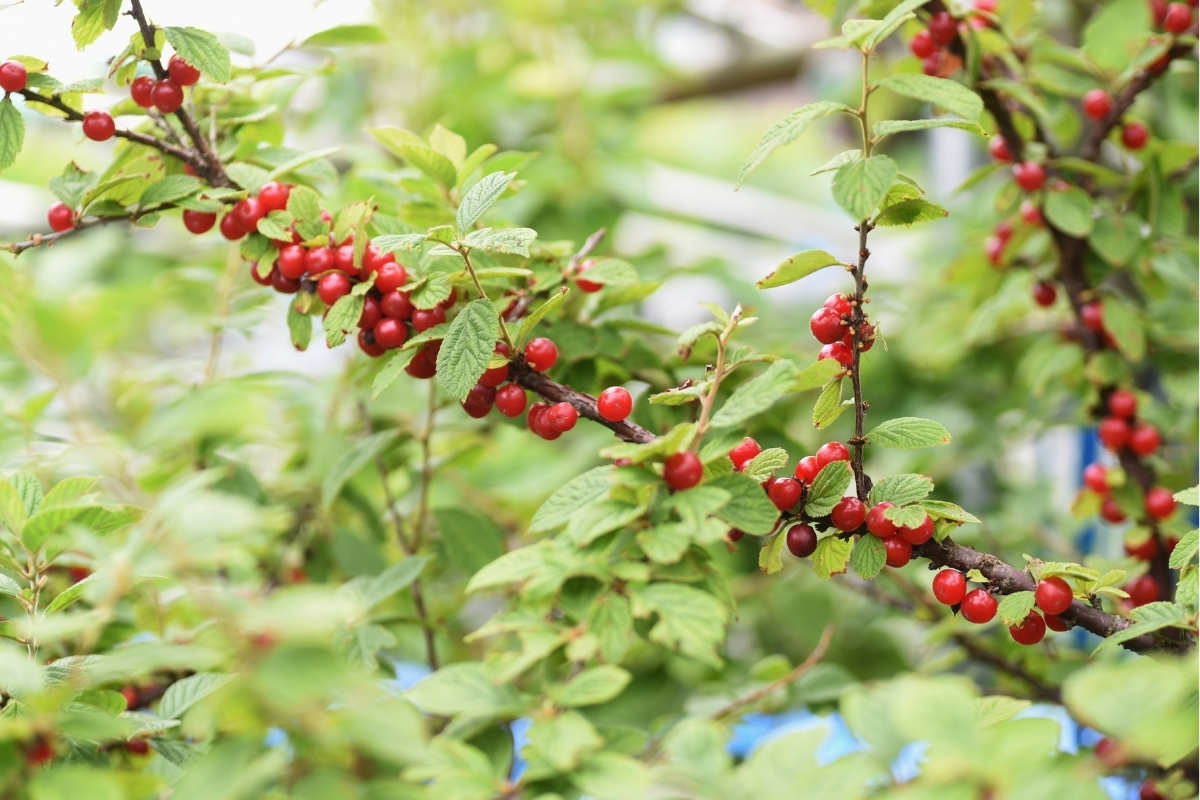
Planting Nanking Cherry
Finding nanking cherry saplings at a local garden nursery isn’t easy; they’re not as common as other fruit trees in the United States.
We’re lucky in that many of our local Vermont nurseries specialize in fruiting trees and shrubs, with a focus on unique permaculture plants. Mail-order nurseries have started to stock them as well, and you can find them at Nature Hills Nursery.
We planted our nanking cherry bushes from dormant bareroot plants, but they can also be grown from seed.
Growing Nanking Cherry from Seed
Planting nanking cherries from seeds means that your plants might not breed true. The same is true when you grow apple trees from seed.
Each fruit contains a seed that leads to a shrub with similar qualities to the parent, but it might be taller, shorter, wider. The seeds might produce fruit that tastes better or worse or ripen to a different shade.
Nanking cherry seeds require cold stratification for two to three months for optimal germination because, in nature, the seeds have time in the ground over the winter to germinate.
There are several ways to replicate this at home:
- Place the seed into a pot of wet sand, sphagnum peat moss, or vermiculite, checking the moisture level frequently.
- Dampen a paper towel, seal it in a bag with the seeds, and keep it in the refrigerator for 100 days to mimic nature.
- Plant the seeds outside in the fall and let nature achieve stratification. The problem with doing this is that moisture levels are hard to monitor, and rodents love to eat the seeds.
Propagating Nanking Cherry From Cuttings
If you have a neighbor or a friend growing a nanking cherry, propagating through cuttings is your best (and easiest) bet. It’s also the only way to grow a true-to-type nanking cherry; it will be identical to the parent shrub.
Take a softwood cutting that measures 8-12 inches when the fruit is ripening, treating the base of the cutting with rooting hormone to help establish.
An alternative is to take a 8-12 inch hardwood cutting from one-year-old wood. Use rooting hormone and plant in soil in the fall or spring.
Both of these methods are described in detail in my articles on growing elderberries from cuttings (as well as this article on growing blueberries from cuttings).
Nanking Cherry Pollination
Something you have to remember is that nanking cherry trees don’t self-pollinate. You need two or more shrubs for cross-pollination that are planted within 100 feet of each other.
Closer is better if you have the space.
If you’ve gotten cuttings from a friend, you’ll need cuttings from two distinct plants. (Or, you’ll need to have a neighbor that’s growing a genetically different cultivar.)
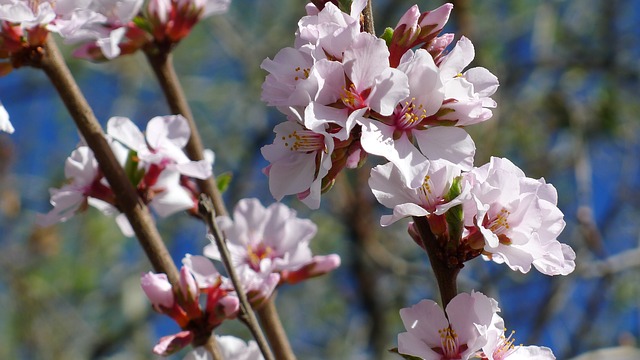
How to Grow Nanking Cherry
Preparing the soil for planting your new shrubs is easy.
Add compost to the area and hole because it adds nutrients as well as increases drainage. Most fruit trees don’t like standing water because it increases the risk of bacteria and root rot, which is impossible to treat.
It’s best to test the soil before amending to determine the pH range. Soil at a pH of 7.0 is considered neutral, so once you find out the level of your current soil, adjust appropriately.
Add limestone to soil that is too acidic to increase the pH. Products such as elemental sulfur will lower the pH if it’s too alkaline, and they’ll usually come with application rates on the package.
A soil test also shows if your soil lacks phosphorus. It’s crucial to add phosphorus (if it’s low) when you plant the shrub because it helps initial root development.
Phosphorus is immobile in the soil, so applying it to the soil surface later is pointless. It won’t move down into the soil to the roots.
Once you prepare the soil, make sure you have the proper spacing between Nanking cherry bushes.
If you plant several to create a hedge or windbreak, a spacing of six to ten feet is sufficient. For single or stand-alone shrubs, plant them 8-15 feet apart for easy pruning and harvesting.
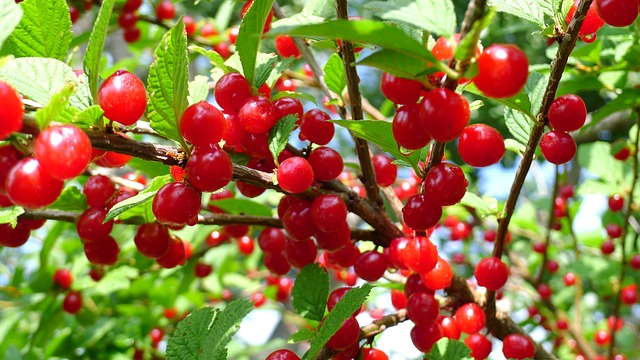
Caring For Nanking Cherry Bushes
One reason to grow nanking cherries is that they’re low maintenance. Once established, there is little that you need to do on a regular basis. They have a short life span when compared to other fruit trees (which can live for centuries), but they still should last a generation.
With optimal care, nanking cherries can live for 50 years.
New nanking cherry shrubs need frequent watering to help the roots establish. Plan to water twice per week deeply. Drip irrigation helps to conserve water and reduce diseases by reducing water on the leaves.
An established nanking cherry shrub is fairly drought resistant. It survives in areas with as little as 12 inches of precipitation yearly. If you live in a region with more natural precipitation yearly, there is no need to water your established tree.
It’s not necessary to fertilizer these shrubs unless you want to do so, as they’re naturally low feeders. That said, if you find your nanking cherry is producing small crops (and it has adequate sunshine), consider light fertilizer applications.
Mulching is recommended because it reduces weeds, which are competition for nutrients, around your shrub. Place mulch around the base of your young tree in the first year.
We mulch with either wood chips from our tractor drive chipper, or with homemade bark mulch.

Nanking cherry is a fast-growing cultivar, which isn’t a problem if you have ample space (as we do). In the suburbs or a small yard, you’ll want to prune it regularly to keep your bush from reaching up to 15 feet tall.
Pruning encourages this plant’s natural spreading growth habit and makes it much easier to harvest the fruit. It’s possible to trim this shrub into a hedge with persistent pruning.
Prune the center of the shrub for proper air flower and light penetration, reducing the risk of fungal infections.
Always look for dead or diseased branches that need to be removed. If you notice that your shrub is producing less than previous years, a severe pruning back down to the ground triggers a quick rejuvenation.
Common Pests and Diseases
Nanking cherry trees have few pests or disease problems. It’s one of the reasons why these trees are so easy to grow. Most gardeners watch for the same pests and diseases that affect sweet and tart cherries.
Though Nanking cherry pests are uncommon, they’re not unheard of. Keep an eye out for these common cherry pests:
Spider Mite
Spider mites are tiny arthropods that enjoy feeding on the underside of leaves. If you see stippled leaves, it’s a sign of mite feeding. Severe infestations create fine, silken threads on the leaves and stems. The major issue with spider mites is that they reproduce so quickly that an infestation turns bad quickly.
Most gardeners ignore small populations, but since they reproduce so fast, keeping a close eye on them is best. If your shrubs are infested, apply insecticidal soap or horticultural mineral oils every week.
Western Cherry Fruit Fly
The adults have a distinct banding pattern on the wings, making them easy to identify. These fruit flies lay eggs by piercing through fruit when the fruit is a salmon color. That causes white maggots to grow inside of the fruit.
The best thing to do is hang yellow sticky traps throughout your garden. Treating the fruits with spinosad helps to reduce the risk of them laying eggs inside.
Black Cherry Aphid
This variety of aphids are small and black. They like to attack to the underside of the leaves, sucking the sap out of the leaves and leaving behind honeydew.
Small populations of aphids aren’t harmful, but large populations can cause problems. The honeydew attracts ants and sooty mold, both of which lead to issues.
Coryneum Blight
This is a fungal disease that causes round, purplish-black spots to develop on the leaves. Over time, the spots fall apart, leaving holes all throughout the leaves.
Pruning and destroying the infected branches is the best course of action. There is no way to kill off this fungus entirely, but applying a copper-based spray in the fall reduces severe infections.
Root Rot and Crown Rot
Pathogens in the Phytophthora genus cause root and crown rot diseases in all fruit and nut trees. Nanking cherry is no exception! When the soil around the base of the shrub remains wet for long periods, it causes the disease to appear.
Trees wilt and die quickly when infected. At first, the leaves may be dull green, yellow, or red. The symptoms start typically on one branch and rapidly spread to the rest of the tree.
Most of the time, the tree is a loss, but cutting away affected bark at the soil helps crown rot. Sometimes, trees may be saved by removing soil at the base of the tree, letting the crown dry out.
Applying a general fungicide might help an early infection.
Harvesting Nanking Cherry
Nanking cherries are a dark red fruit that taste similar to a tart cherry. The fruits ripen in July and August with heavy yields between 12-15 pounds per bush.
The cherries stay fresh on the shrub for two to three weeks after ripening. At this point, it’s recommended to place a net over the shrub because birds will steal many of your cherries.
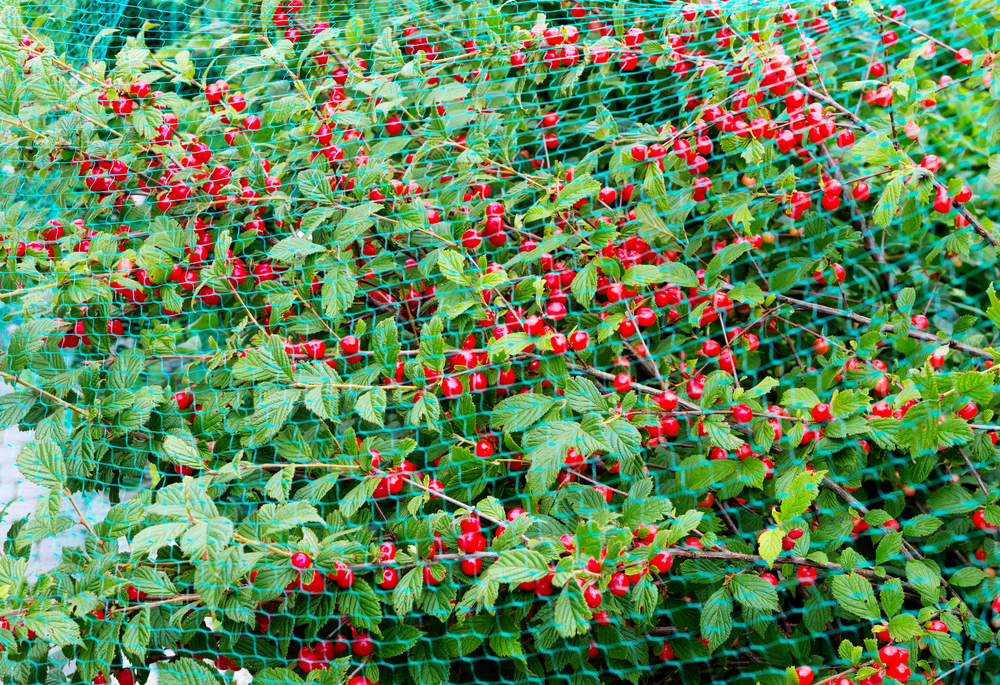
Hedges of nanking cherry are sometimes planted as a “bird lure” to lure the birds to the dense patch of fruit (and away from other summer ripening crops like tree cherries and blueberries).
Harvest the cherries when they’re fully colored and juicy. Remember, there is a pit in the center of the fruit that needs to be removed.
While they look similar to cherries, they are softer than other species; their short shelf life is why you won’t see these even in specialty stores. Soft fruits bruise and spoil easier, so careful harvesting is best.
Like other cherries, nanking cherries have pits that need to be removed before eating or processing. Since they’re so small and delicate, take out the pits right before eating.
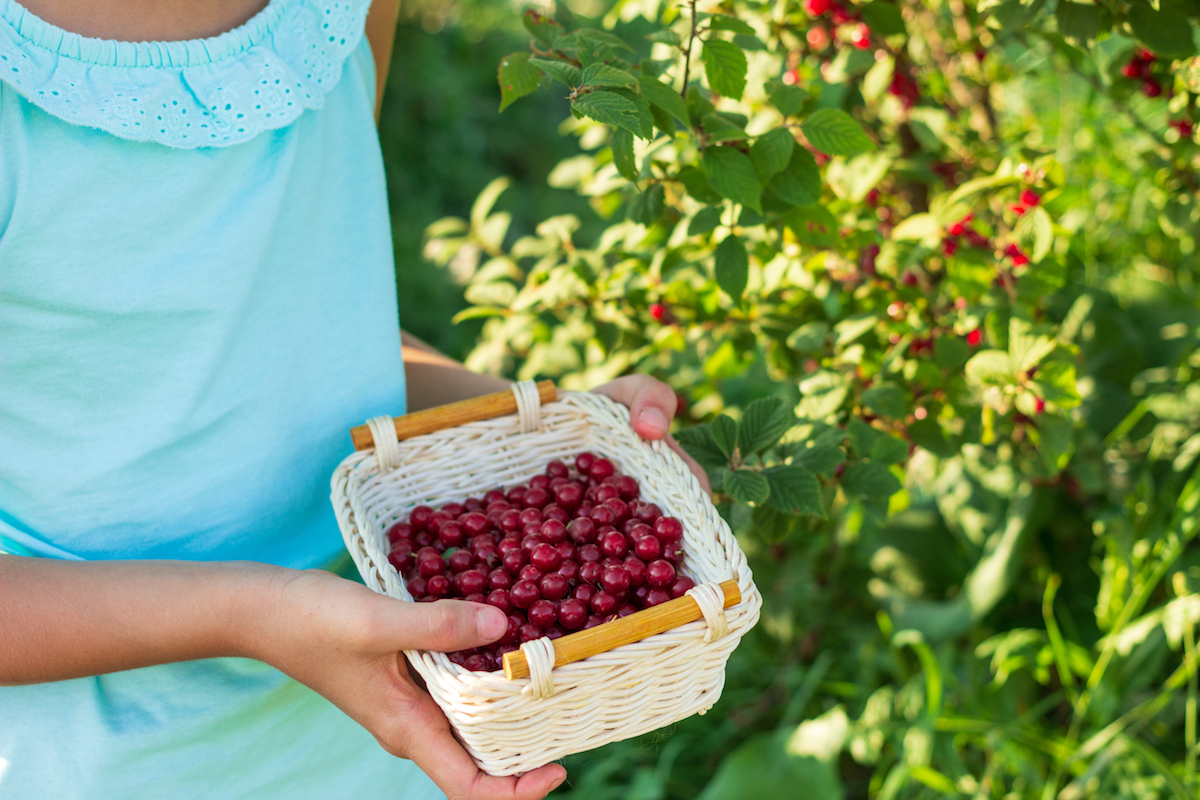
Nanking Cherry Recipes
Commercially, nanking cherries are used for preserves, juicing, wine, syrups, and pies. While keeping these fruits fresh in your refrigerator is hard, there are dozens of ways to enjoy these fruits and ensure they never go to waste.
The hardest part about using nanking cherries is that the pits must be removed but they’re smaller than average cherry pits. So, standard-sized cherry pitters don’t work.
One genius at Homestead Laboratory discovered that adding a washer inside of a standard pitter makes it usable for nanking cherries.
Another option is to cook the cherries down and strain them with a fish mesh sieve. Doing so catches the pits and cooked skins without all of the work of pitting.
Putting the whole fruits through a steam juicer is incredibly effective as well, and it extracts the flavorful juice without the need for pitting. It’s great for wine, jelly, syrup, or just drinking fresh from a glass (perhaps with a bit of sugar).
Try any of these nanking cherry recipes:
- Nanking Cherry Fruit Leather
- Nanking Cherry Jelly
- Nanking Cherry Pancake Syrup
- Nanking Cherry Cheesecake Bites
Nanking cherries can also be used in place of tart cherries. They have a slightly different flavor, but they’ll cook up the same way:
Fruit Growing Guides
Looking for more fruit growing guides?
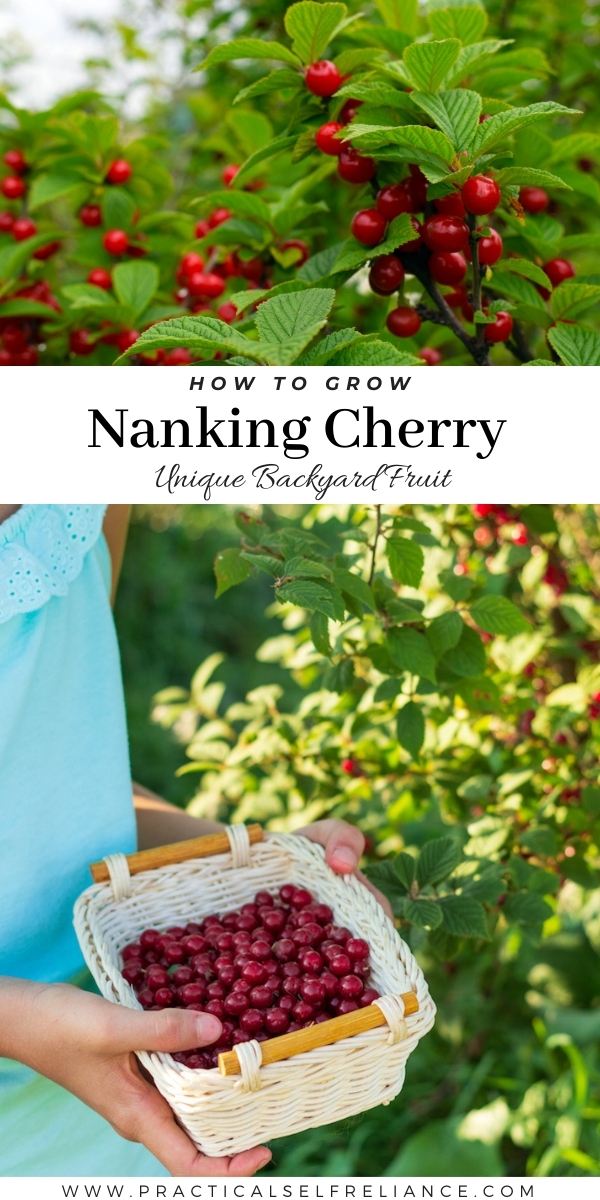




What would be the best time during the year to prune Nanking cherry to the ground?
We don’t typically prune ours to the ground.
I grew this a million years ago when I lived in OK. I LOVED them. I gave up gardening for a long time when I moved to Elk & Deer country! But now I want to grow these again for my bees. I’ve just purchased 5 seedlings online (greenwoodnursery.com) but also some nanking seeds. Do I need to crack open the seeds like I would a peach pit or just plant them “as is”. I’m planning on starting the seeds outdoors in a pot and let God stratify the seeds for me.
If you purchased the seeds then I would think that they should be ready to go but you could contact the seller to be certain.
Were they tested next to black walnut or is that an assumption? I have elderberries, cherry, plum, pear, and apple growing next to walnut stumps.
There are several factors to consider here. Juglone is toxic to many plants although some are more sensitive to it than others. Some are very tolerant of Juglone. The type of walnut tree matters as well. The English walnut does have moderate amounts of juglone but it isn’t known to cause issues like the black walnut does. The roots of the black walnut tree will contain juglone for many years but eventually, the juglone will break down. So if the tree has been cut down for a while, it’s possible that much of it could have dissipated by now.
We have had one for about 20 years and this is the first year we have gotten fruit from it we live in Michigan’s upper peninsula, which I think is zone 5A. Is this normal or any suggestions for a better yeild it was very low.
If you’re not getting a lot of fruit. The issue is most likely pollination. The Nanking Cherry is not self-pollinated meaning it needs other shrubs growing nearby to cross-pollinate.
My only problem with my Nanking is that we get frost nearly every year after they have begun to flower. I am in Colorado, zone 5.
That’s tricky, and we’ve had that problem too with late frosts. They’re just like peaches in that way. This year it’s crazy warm and has been all spring, I’m thinking we’re going to get a good crop.
Great article, I am sold on Naking Cherries! I have attempted to plant other tree seeds before, but lost most of them to the chipmunks and squirrels. Do you have a method to keep critters away while seeds mature into seedlings? I would like to do 100 or more seeds. Thanks
Start them in a protected bed covered with chicken wire. Once the seedlings sprout and are about 6 months old you can lift off the chicken wire (or cut it off, depending on how the plants have grown into it).
OK, we are in zone 6 in KY – I had my cherries along our driveway, instead of the back yard (which is much higher and flatter) where we garden and grow fruit trees – I’m thinking that the front yard is much colder, more prone to frosting. We would get blooms and then another freeze/frost would happen and I think all the blossoms would freeze. We ended up pulling them – lol – I sadly wasn’t home and they were burned instead of moved . . . So, I would think they could handle much colder weather. Does it take 4-6 years for the fruit to really get going? At any rate, I think I’m ready to try again in a diff. location. I have blueberries in the back yard and think I could put some back there . . . just want to know if they are prone to frost damage that we could wrap them if we have a frost coming or if I should have just waited a few more years. Thanks for the awesome article!
I love your post ! Thank you!
I am in South East Vermont. We have grown Nanking cherries for at least 20 years. I bought them from Gurneys. I have only make jelly with the juice. It is one of our favorite jellies. Mine are mostly in shade, get some morning sun. I have had them pop up in others parts of our year. I’m assuming from birds. It is nice that there are so many that you can share with the birds. Mine are two different varieties and two different shades of red. One is paler and more shiny when ripe.